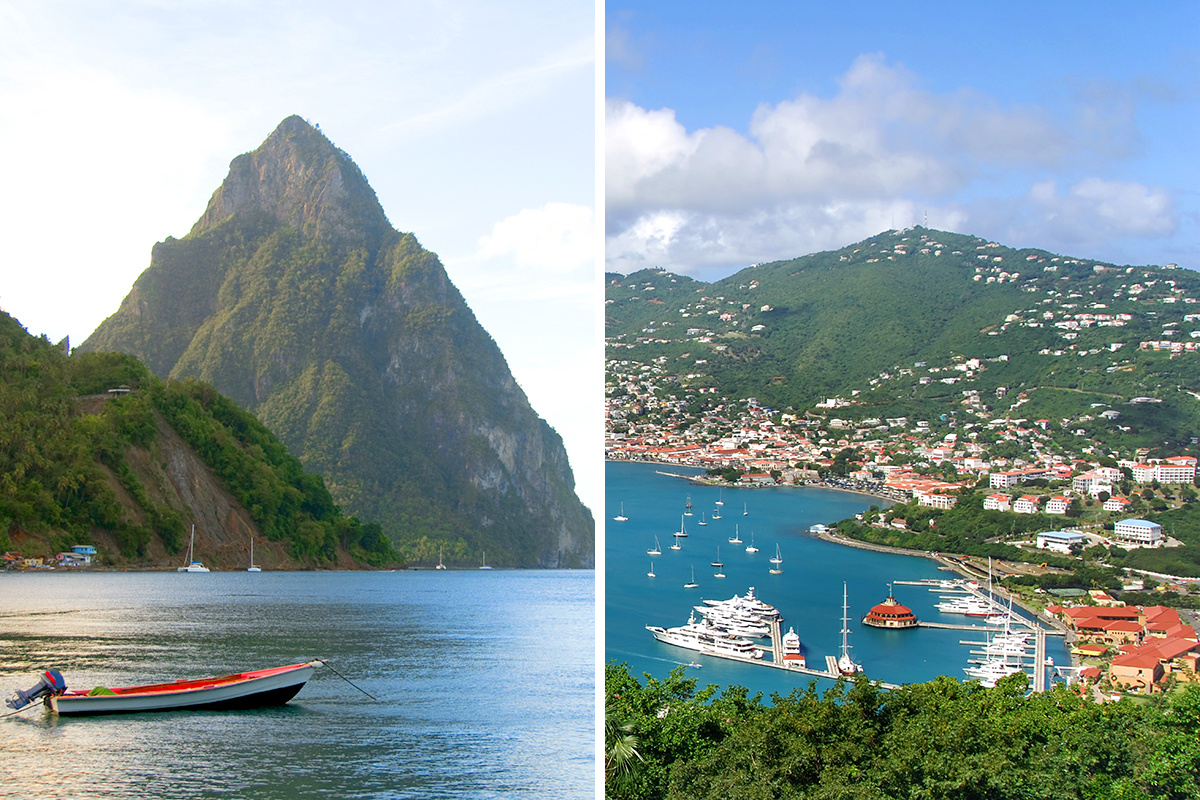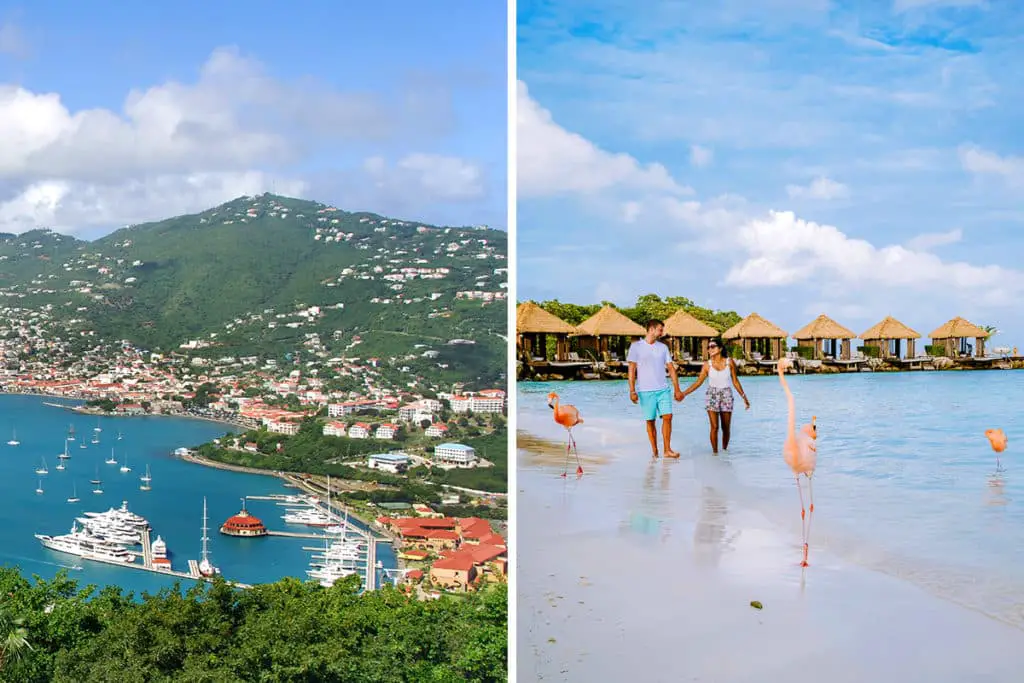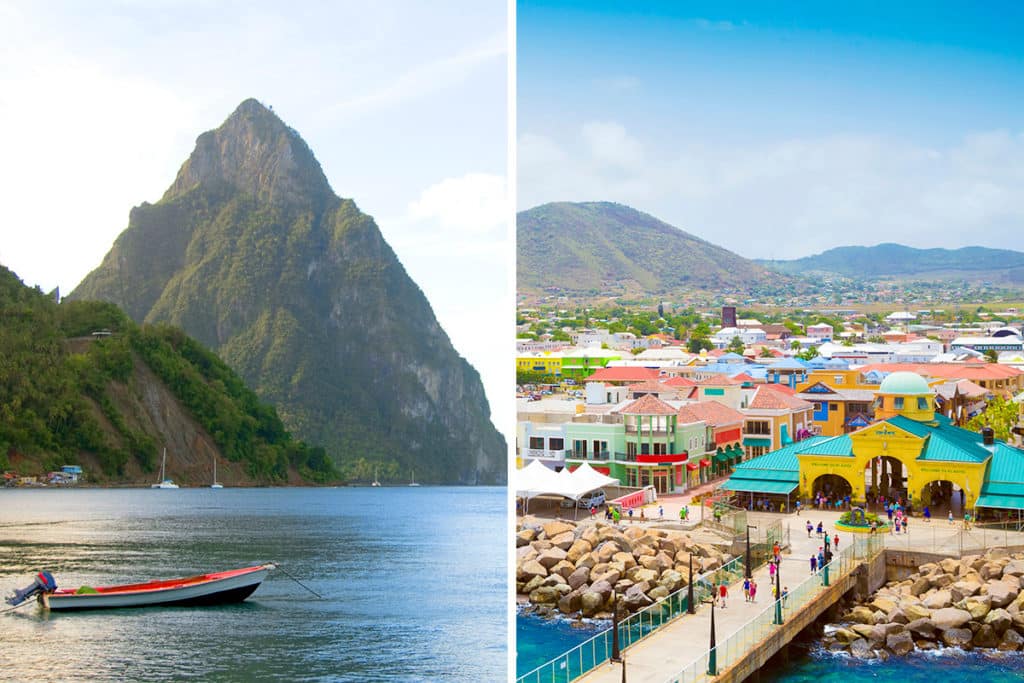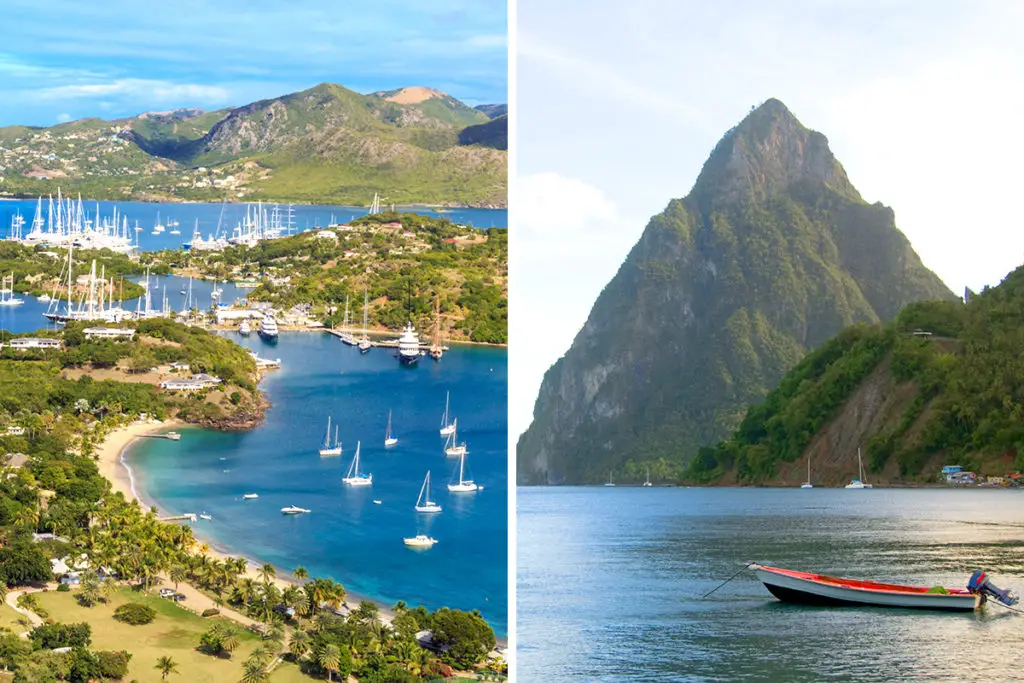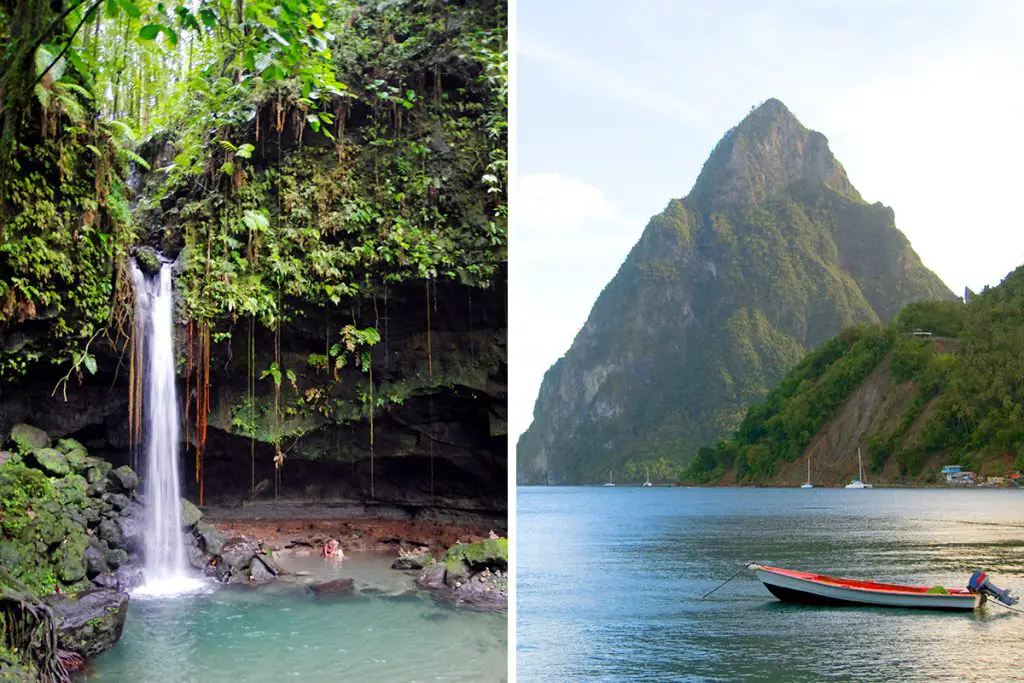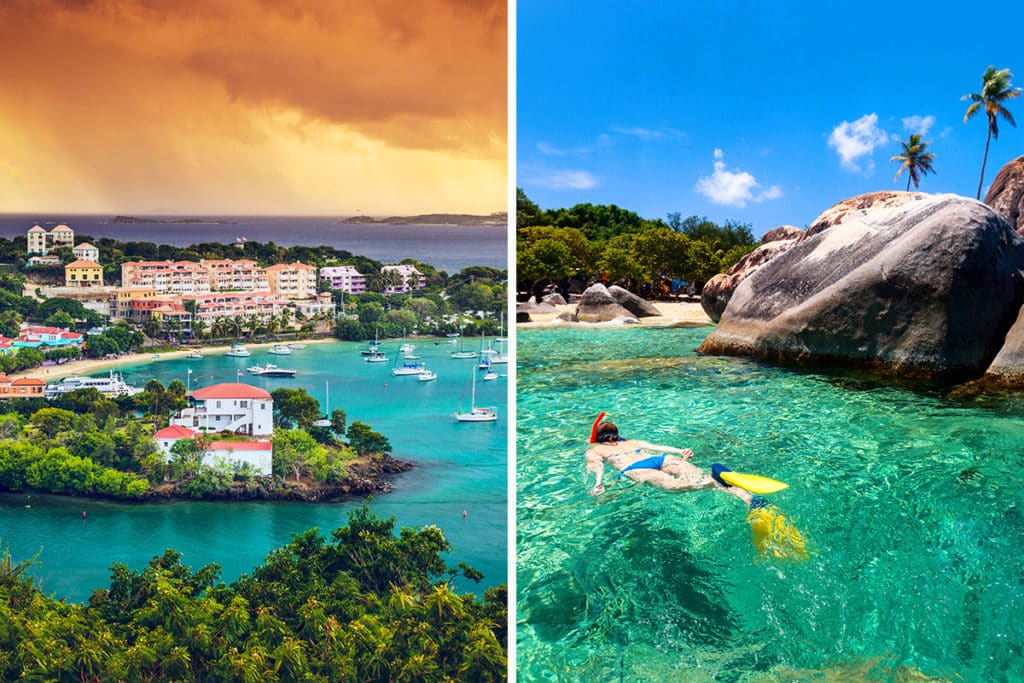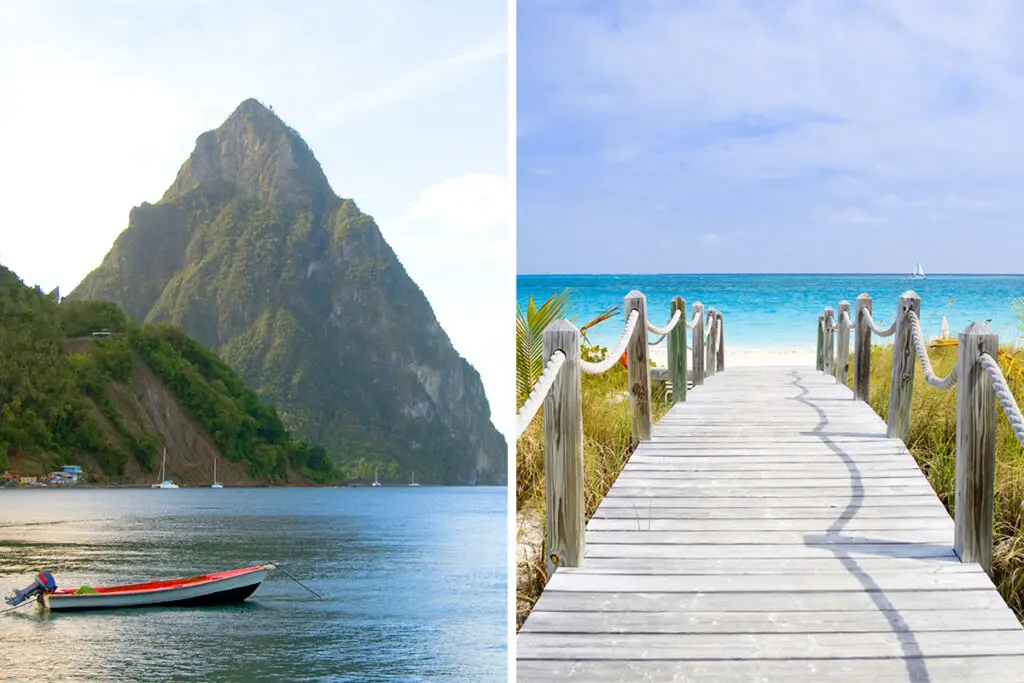St. Lucia is a quaint island in the Caribbean’s southeastern end. Although small, St. Lucia is considered to be one of the most beautiful islands in the region. It features some of the world’s most iconic landscapes that put tourists in awe.
St. Thomas is an up-and-coming tourist hub in the Caribbean. It is primarily known for its world-class shopping and upscale tourism industry.
Compared to the most visited tourist destinations in the Caribbean, traveling to smaller islands such as St. Lucia and St. Thomas can provide a more intimate experience. But the question is, how do you choose between the two?
St. Lucia
St. Lucia is one of the islands that make up the Caribbean’s Lesser Antilles region. This part of the Caribbean features small and mostly isolated islands. This allows the development of diverse and unique cultures despite the islands neighboring each other.
The island of St. Lucia is characterized by soaring peaks and grandiose mountain ranges. Aside from that, a significant part of St. Lucia is covered with lush rainforests. With its towering green mountains and striking blue coastline, the island provides beautiful scenery from each and every view.
Although the island is considerably rugged, much of its tourism banks on its landscapes. From climbing a mountain over 3,000 feet (914 m) high to hiking up one of the region’s most dangerous volcanic spires. St. Lucia’s landscapes provide scenic beauty and thrilling adventures as well.
Ranked as one of the most beautiful places in the Caribbean, many learn about St. Lucia because of its beauty. However, tourism on the island is more than just sceneries and views. Tourists heading to St. Lucia can also enjoy, explore, and uncover a whole variety of tourist attractions.
What Makes St. Lucia Unique?
Caribbean’s Most Beautiful Beaches
The Caribbean region is known for its multitude of paradise islands. There are hundreds of islands encompassing the region and its location in the globe provides hot and humid weather all year round. Because of this, people often think of summer and the tropics when it comes to the Caribbean region.
From humongous island nations to smaller archipelagos, their tropical beauty is sought by people all over the world. Although there are hundreds of different islands in the Caribbean region, some are more beautiful than others. St. Lucia is blessed with natural beauty. Some of its most notable features are its amazing beaches.
Different parts of the island provide unique but equally beautiful coasts. From rocky beaches with strong waves suitable for surfing to white-sand beaches with calm waters. St. Lucia provides tourists with a variety of beaches that offer unique experiences.
Rodney Bay
Rodney Bay is located in the northwestern part of St. Lucia. It is one of the island’s most developed coasts. Part of the bay was actually a man-made lagoon featuring some of St. Lucia’s most popular hotels and resorts. It features a horseshoe shape that provides expansive views of the horizon.
Rodney Bay is one of St. Lucia’s primary tourist hubs. It features a long stretch of pristine white-sand beach with crystal clear waters. But aside from its sandy beauty, Rodney Bay also has an array of tourist attractions and activities nearby.
At one end of the scenic Rodney Bay is the historic Pigeon Island National Park. The island is one of St. Lucia’s most popular tourist sites. Visitors can also enjoy numerous water activities at the Splash Island Water Park.
Rodney Bay is also home to one of the Caribbean’s largest marinas. The infamous Rodney Bay Marina consists of 253 slip berths, including 32 fixed megayachts docks.
Reduit Beach
Reduit Beach is considered one of the most famous beaches in St. Lucia. The stretch of palm-lined soft golden sand charms tourists and locals alike. Many people flock to the beach because it is within a short walking distance of numerous resorts and hotels in the Rodney Bay district.
Reduit Beach sits adjacent to the famous Rodney Bay Marina and has expansive views of the nearby Pigeon Island. The beach is also one of the best spots in St. Lucia to watch the sun set and rise. Aside from its beauty, Reduit Beach is famous for its many water attractions and activities.
The water around this part of the island of St. Lucia is calm and gentle. Also, a significant portion of the beach features shallow waters. This is perfect for families and even kids to enjoy casual swims on the beach. Its clear azure waters also provide amazing opportunities to go snorkeling and diving.
There are several stores and establishments along Reduit Beach that offer different water activities. Although the beach is typically calm and gentle, the wind picks up from time to time. This provides the perfect setting for water sports such as windsurfing, sailing, and waterskiing. Tourists can avail lessons and borrow equipment from the numerous establishments by the beach.
Because of its popularity, some complain that the beach can be too overwhelming. Local vendors scatter around the beach and approach people to sell their goods. This happening several times throughout the day can be bothersome at some point.
Anse Chastanet Beach
The Anse Chastanet Beach is located within the island’s Anse Chastanet Marine National Park. Considered one of St. Lucia’s top snorkeling spots, the marine national park protects and preserves an expansive coral reef system along the island’s western coast. Anse Chastanet features wondrous beauty in and out of the water.
The Anse Chastanet Beach lies closest to the city of Soufriere. It is easily accessible through the Old French Road and is open to the public for free.
The beach is tucked between rocky outcrops on both ends and opens to the marine reserve. There is a handful of resorts established in front of the Anse Chastanet Beach. However, people can still reach the site via car or boat. To avoid damaging the reef, buoys are placed around the perimeter of the marine reserve to keep boats at bay.
Considered one of the Caribbean’s best snorkeling sites, most people heading to Anse Chastanet come to explore its expansive coral reef system. Although the beach itself is still equally beautiful, featuring palm trees and fine sand. Regardless, the main attraction of Anse Chastanet lies beneath the water.
The Anse Chastanet Beach feature designated snorkeling zones. The zoning system is used to refer to certain parts of Anse Chastanet with a unique characteristic. The coral reef system starts within 45 feet (14 m) of the beach and the water is relatively shallow by this point. The coral reef system changes in composition as the reserve extends further out and deeper into the ocean.
Aside from snorkeling and diving, visitors can also enjoy other water sports. Windsurfing and sunfish sailing allows tourists to enjoy the gentle Caribbean breeze. Ocean kayaking is also a good way to observe the reserve’s marine life without going under the water.
The Island’s Iconic Piton Mountains
St. Lucia’s natural landscape is dominated by the infamous Piton Mountains. Although the two mountains are not the island’s highest peak, they are one of St. Lucia’s most photographed landmarks.
Located along the island’s southwestern coast, the twin peaks serve as the island’s defining icon internationally.
The Piton Mountains are volcanic spires that are nearly identical in terms of shape and height. They are located on each side of the town of Soufriere and are one of the most visited attractions in the region. Hiking the towering peaks is a popular activity for people visiting the island.
The Petit Piton is the smaller mountain between the two. Standing at 743 m (2,438 ft) high, this towering peak is considered a challenging and dangerous hiking destination. This is because the mountain is characterized by rocky and rugged terrain. It is also significantly slimmer, making the elevation more drastic at each height.
Climbing Petit Piton requires a special permit to ensure that the climbers are well equipped and experienced to take on the treacherous mountain. The peak of Petit Piton provides panoramic views of St. Lucia and its southwestern coast. Some can spot the nearby islands of Martinique, Dominica, St. Vincent, and Barbados on clear days.
The Gros Piton is the larger among the two spires. It stands at 798 meters (2,618 ft) and is a popular hiking spot for tourists. Compared to the other Piton, Gros Piton is a lot wider. This allows for a safer ascend to the top. Hiking up the Gros Piton is open to everyone and usually takes several hours to reach its highest peak.
Scenic Hiking Trails
St. Lucia is a geographically interesting island. With a total area of 617 sq. km (238 sq. miles), the features a variety of landforms including mountain ranges, rolling hills, and volcanic spires.
The island of St. Lucia is relatively small compared to other major islands in the Caribbean. Despite this, St. Lucia still amazes people with its wondrous natural beauty. The interior of the island is dominated by the grandiose Mount Gimie. This continuous mountain range serves as a central ridge and bisects the island into two regions.
St. Lucia’s rugged and lush landscapes make it an amazing place to explore. Given that the island consists of several mountains, there are also numerous hiking trails for tourists to take on.
Hiking trails on St. Lucia vary in difficulty. Some can take hours while others can be completed within minutes. Regardless, visitors can agree that these hiking trails provide opportunities to better appreciate the island’s majestic beauty.
Tet Paul Nature Hiking Trail
The Tet Paul Nature Hiking Trail is one of the most popular hiking trails near the town of Soufriere. The trail is a loop that traverses the island’s Piton Mitan Ridge and provides amazing views of St. Lucia’s Piton Mountains.
The Tet Paul features a well-marked trail that is within easy to moderate difficulty. The walking trail is clear and there aren’t many rugged or treacherous paths. Visitors can complete the whole trip in less than an hour. The Tet Paul Nature Hiking Trail is a popular choice for those who cannot hike up either of the Pitons.
There are several lookout points throughout the Tet Paul Nature Hiking Trail. At its highest peak, the trail provides scenic views of Gros Piton and Petit Piton. People can also view the nearby towns of Soufriere, Chousiel, and Laborie. It is also possible to see the neighboring islands of St. Vincent and Martinique from Tet Paul Nature Trail on clear days.
Pigeon Island National Park
The Pigeon Island National Park is located right at the northwestern tip of St. Lucia. It was once an isolated island but an artificial causeway was built to connect it to the mainland.
Pigeon Island plays a significant role in St. Lucia’s history. Because of its strategic location off the coast, the island served as an overlooking point for military forces. The island is home to a fortress and several building ruins.
Hiking trails on Pigeon Island pass through several military ruins. There are also a handful of signages providing information about the buildings and the island’s history.
Pigeon Island has two peaks located on either end of the island. The historic Fort Rodney is considered one of the peaks and is a popular attraction among tourists. The trail up the military fortress is relatively easy, allowing most tourists to reach the fort with little to no problem. The taller Signal Hill is a lot more challenging as the hike up is a lot more rugged and steeper.
Enbas Saut Waterfall Trail
The Enbas Saut Waterfall Trail is an underrated hiking trail in St. Lucia. Compared to the Pitons or the Tet Paul trails, there are not a lot of tourists who know about the scenic hike up the Enbas Saut Waterfall. Although not as popular, this wondrous hike right in the heart of the island of St. Lucia does not disappoint.
Located deep within the Edmund Forest Reserve, the hiking trail takes tourists to the grandiose Mount Gimie and away from the hustle and bustle of the island’s tourist hubs. This particular trail does not feature a ton of panoramic views. However, it is considered to be an amazing way to explore the island’s lush rainforest and rich biodiversity.
The Enbas Saut Waterfall is a challenging 4 km (2.4 mi) loop that takes roughly 2 hours to complete. Guided trips to Enbas Saut Waterfall consider it a half-day expedition. This provides tourists enough time to explore and enjoy each and every aspect of the hike. From finding unique flora, discovering local fauna, and swimming through Mount Gimie’s river system.
Unique Experiences at Soufriere
The quaint town of Soufriere sits in between the towering peaks of the Pitons. Many tourists include Soufriere in their trips because of its proximity to the iconic landmarks. However, Soufriere is more than just an entry point to the Pitons.
The charming city was first established by French communities and later occupied by the British. Both cultures are well reflected in Soufriere’s culture and architecture. Numerous brightly painted wood shacks and colonial-era buildings bring the city a vibrant atmosphere. It was once the capital city of St. Lucia and it is home to nearly 3,000 people.
Soufriere’s tourism is like a microcosm of the whole island of St. Lucia. It features lush mountains, fantastic hiking trails, pristine beaches, and a rich cultural heritage. The city also developed in terms of accommodation options. Tourists can find hotels and resorts by the beach, as well as lodging by the city center and up the mountains.
Sulphur Springs Park
The Sulphur Springs Park in Soufriere is known as one of the most visited tourist destinations on the island. Recognized as the only drive-in volcano attraction, the site sits on what is considered one of the most active geothermal fields in the Lesser Antilles.
The tourist attraction was a result of the Soufriere Volcano’s crater collapsing. The weak spots and cracks in the volcano led to boiling hot springs and mini craters out in the open. For a while, a sulfur mine operated in the area and harvested more than 500 tons of sulfur from the volcanic mountain.
A road passes through the center of the geothermal field, allowing visitors to see steaming pools and fumaroles right next to the road. The temperature of the water in these pools reaches 212 F (100 C). There is a strong distinct stench as the sulphuric pools boil the water with copper, iron oxide, alkaline lead, calcium oxide, and carbon deposits.
The 44-acre (17 ha) park features several attractions and activities. Tourists can take guided tours around the park and learn more about the island’s geothermal history. However, the park’s most popular attraction is the infamous mud baths.
Sulphur Springs Park features numerous mud pools that consist of warm black-water mud baths that are safe for people to swim in. The heat of the thick muddy pool is claimed to provide health benefits by alleviating joint pain. Aside from that, it can also help with skin problems such as sunburn and eczema.
To complete the rejuvenating experience, tourists often head over to the park’s Toraille waterfall to freshen up.
Diamond Falls Botanical Garden
The Diamond Falls Botanical Garden is located within one of the oldest estates in St. Lucia. The Soufriere Estate was part of the granted land by King Louis XIV of France to the Devaux family. The 2,000-acre (809 ha) land serves as a recognition and reward for their service.
The Diamond Falls Botanical Garden lies within the area of the collapsed crater of the Soufriere Volcano. Taking this into consideration, parts of the Soufriere Estate are also geothermally active. This includes the waterfall, hot springs, and stream that passes through the estate.
In the early 18th century, King Louis XVI funded the construction of stone baths in the estate after learning about its health benefits. However, war and conflict during the later 1900s led to the destruction of the said stone baths. The structures were only reconstructed by the owner of the Diamond Estate, initially for his personal use.
After the completion of the stone buildings and stone baths, the owner, Andre du Boulay, opened the site to the public. The site is now known as the Diamond Falls Botanical Garden.
Recognized as one of the most popular tourist attractions in Soufriere. the botanical garden is known for its collection of flora. It covers a total of 6 acres (2.4 ha) and has developed to be a multi-awarded tourist site.
The grandiose botanical garden is lauded for its well-landscaped gardens. The garden tucked amidst the already lush mountain provided a calm and scenic atmosphere for visitors. Well-marked and clear walking trails allow tourists to explore the site at their own pace.
Morne Coubaril Historical Adventure Park
The Morne Coubaril Historical Adventure Park is located in one of the few remaining estates in St. Lucia. Located a little outside of Soufriere’s town proper, the park lies within a 250-acre (101 ha) estate. Louis XIV of France granted the land which was used for cocoa, coffee, and copra plantations.
There are a variety of tours and activities available at the Morne Coubaril Historical Adventure Parks. For thrill-seekers, the adventure park features a zip-line canopy adventure. Several zip lines are installed at different points of the 250-acre (101 ha) estate. The adrenaline-inducing activity takes visitors flying above the canopy, overlooking Soufriere.
The park also offers historical and educational tours. The Historical Estate tour takes tourists through a replica of a small village imitating life on the island hundreds of years ago. It also includes a quick trip over to the Monplaisir’s family mansion.
The park’s Rum and Chocolate Tasting tour draws a lot of attention. This 40-minute activity takes participants through the sugar cane and cocoa plantation. The guide also explains every step of the production process. At the end of the tour, visitors get the chance to taste the locally produced rum and raw chocolate from the estate.
Fond Doux Plantation
The Fond Doux Plantation is a 19th-century plantation dedicated to cocoa farming. Located within the UNESCO World Heritage Site of the Piton Mountains, the plantation covers a total of 135 acres (55 ha). The estate features a combination of cocoa fields, lush rainforest, and landscaped gardens. The site is located a mere 10 minutes away from the city center of Soufriere.
Aside from its beautiful environment, the Fond Doux Plantation is also known for its Chocolate Heritage tours. It aims to celebrate the estate’s cocoa heritage through education and immersion. The tour takes and guides tourists through the different steps involved in the cocoa plantation.
It also provides them the opportunity to participate in the cocoa-making process. Visitors can get the chance to create their chocolate from start to finish with the help of local cocoa experts.
St. Thomas
St. Thomas is another small island located in the Caribbean’s Lesser Antilles region. The island is part of the archipelago referred to as the Virgin Islands. Along with the islands of St. Croix, St. John, Water Island, and Hassel Island, they make up the group known as the US Virgin Islands.
Dubbed as the gateway to the Caribbean, St. Thomas is the closest island off the coast of the larger Puerto Rico. It is home to the Charlotte Amelie port and is a popular stop for luxury cruise ships traveling through the Caribbean region. It has a total area of 83 sq. km (32 sq. mi) and is home to more than 50,000 people.
St. Thomas is known for its upscale tourism because it is a common stopover for cruise ship goers. It is a beautiful island with numerous natural bays that serve as harbors. Along with its long history, rich cultural heritage, and booming tourism industry, St. Thomas is an amazing place to land in the Caribbean.
What Makes St. Thomas Unique?
Retracing History at Charlotte Amalie
The city of Charlotte Amalie is located along the southern coast of St. Thomas. It serves as the nation’s capital and it is also the largest and most populous city in St. Thomas. Charlotte Amalie features a deep natural harbor used as one of the island’s commercial ports.
Charlotte Amalie’s port is recognized as one of the busiest ports for cruise ships in the Caribbean. It also harbors yachts and ferries. In total, Charlotte Amalie caters to more than 1.5 million cruise passengers annually.
Considering other modes of travel and transportation, the city is easily one of the most popular tourist destinations in the Virgin Islands as well as the Lesser Antilles region.
The capital city plays an important role in the island’s tourism industry. Because of its nearby port, the city developed to be a major tourist hub. One of the city’s charms is its unique Danish colonial architecture and lavish shopping experience.
They have popular shops and boutiques such as Tiffany, Rolex, and Breitling. These are all catered to the upscale and luxurious taste of most cruise ship passengers who frequent the city.
Outside of the electric energy of the city’s tourist center, Charlotte Amalie’s attractions also offer a glimpse of the island’s long history. Several sites celebrate and commemorate important aspects of the island’s heritage. Learn more about St. Thomas’ history of piracy as well as the numerous remnants of the early settlers of the island.
Blackbeard’s Castle National Park
The island of St. Thomas features several deep bays ideal for harboring ships of different sizes. In its earlier years, St. Thomas was a hot spot among pirates in the Caribbean region. Before luxury cruise ships docked in St. Thomas harbor, pirate ships also frequented the area.
The historic Blackbeard’s Castle National Park is recognized as one of the most popular tourist attractions in St. Thomas. Blackbeard was a prolific English pirate feared by many. He navigated through the islands in the West Indies in the 18th century. Throughout his time as a pirate, he has made his name as a menace and a terror among pirates during the so-called Golden Age of Piracy.
The park encompasses Blackbeard’s Castle, a site that has been designated as a national historic landmark in 1994. The park covers a total of 5 acres (2 ha) and features several historical buildings.
The Blackbeard’s Tower is a watchtower built sometime in the 17th century. It stands amidst a modern-day inn and serves as the landmark of the historic national park. At the top, the historic tower provides commanding views of Charlotte Amalie’s harbor.
Visitors of the park can also tour other historical structures including the Villa Notman, Haagensen House, and Hotel 1829. Referred to as the “Williamsburg of the Caribbean”, these structures are some of the most beautiful on the island.
The Villa Notman is a 19th-century mansion notable for its white cast-iron balcony. Aside from its panoramic views of the harbor, the historic building is home to a collection of Caribbean furniture.
The Haagensen House is another historic landmark. Built sometime in the 16th century, the estate was once owned by a Danish banker. Although the outside architecture is not as impressive, many say that the Haagensen House features one of the most beautiful interior designs on the island.
It also features an amazing collection of life-sized bronze statues of famous pirates of the Caribbean. Among the 19 pirate statues are Blackbeard, Captain Morgan, and Black Bart.
The historic Hotel 1829 once served residence for a wealthy French sea merchant. It is part of the Blackbeard’s Castle National Park historic tour and is the site of the infamous Rumpoureum. A local attraction that features an extensive collection of rum. Visitors can get the chance to participate in rum tasting and learn more about the production process.
Hotel 1829 is also home to the largest amber waterfall in the world which consists of more than 12,000 stones.
The 99 Steps
The 99 Steps of Charlotte Amalie is widely considered one of the most popular attractions of St. Thomas. Built sometime in the 18th century using ballast bricks, the historic steps were used to traverse Charlotte Amalie’s rolling hills with ease.
Although the actual step count is 103, the iconic step street system passes through some of the island’s most historic sites. The climb up Government Hill takes tourists to the historic mansions of St. Thomas. This includes the grandiose Villa Notman, Haagensen House, and Hotel 1829.
Fort Christian
Fort Christian is another historic site located near the heart of the city of Charlotte Amalie. Built from 1672 to 1680, the fort features a distinctive Gothic Revival architecture. Although reconstructed, the site still holds a historical and cultural significance to St. Thomas. It is recognized as one of the oldest colonial structures on St. Thomas.
The historic fort was built to provide added safety and security against pirates and colonizers. Designated as a National Historic Landmark in 1977, the fort is now home to the St. Thomas Museum. Although quaint, the museum features a collection of artifacts relating to the island’s Dano-Norwegian history.
Emancipation Garden
Charlotte Amalie’s Emancipation Garden serves as one of the city’s main squares. Located in Downtown Charlotte Amalie, the historic park was built to commemorate the emancipation of slaves in 1848. On June 3rd, Danish Governor Peter von Scholten granted freedom and ended slavery in St. Thomas.
The park features a bronze statue to commemorate this historic event. It features a man, once a slave, blowing a conch shell that is a symbol of freedom. The Emancipation Garden is also home to St. Thomas’ replica of the renowned Liberty Bell.
There are several other historic buildings around the tranquil park. This includes the Government House and the Emancipation Garden Post Office.
St. Thomas Synagogue
The historic St. Thomas Synagogue is recognized as the oldest synagogue building continuously used in the US. Also referred to as the Hebrew Congregation of St. Thomas, the Jewish community in St. Thomas was founded in 1776.
The construction of the synagogue started in 1803. However, a small fire incident in 1804 damaged certain parts of the structure. After further construction and reconstruction, the first building was completed by 1806. The complete layout of the synagogue dates back to 1833, making it the second oldest synagogue in the US.
Because of its historical significance, the church was designated as a National Historic Landmark in 1977. It features a combination of Greek Revival and Gothic Revival architectural elements.
Stunning Caribbean Coastline
The island of St. Thomas is also famous for having an array of amazing beaches. Although it is relatively small, St. Thomas is still able to provide tourists with what they want – a tropical paradise.
Coki Point Beach
Coki Point Beach is one of the most visited beaches in St. Thomas. Located along the island’s northeastern coast, Coki Beach is the perfect summer destination for tourists, particularly families.
The crescent-shaped beach is lined with resorts, restaurants, and entertainment establishments. Its pearl white sand and calm blue water are perfect for families and kids. Water activities such as snorkeling, diving, and paddle boarding are also available at the beach.
Because of its popularity, Coki Beach tends to be a little crowded sometimes. The beach is typically lined with chairs and umbrellas but these are made available for rent.
Magen’s Bay
Stretching along the island’s northern coast, Magen’s Bay is one of the most developed beaches in St. Thomas. It is widely considered one of the best in St. Thomas and the rest of the Caribbean. Magen’s Bay features a mile-long (1.6 km) stretch of soft white sand tucked between lush green hills.
Although the beach is located within a public park, Magen’s Bay requires a small entry fee. This is used to fund the maintenance and further development of beach facilities.
Hull Bay Beach
Hull Bay Beach is located near the famous Magen’s Bay. Considered to be Magen’s lesser-known cousin, the Hull Bay Beach features a more private and intimate experience for its visitors. It features the same soft sand and clear blue waters.
However, the ocean bottom around this part is notably rocky, making swimming and diving a bit more challenging. The tranquil beach is a perfect spot to lounge by the beach while enjoying the view and warm breeze.
Sapphire Beach
Sapphire Beach is located along the island’s eastern coast. It is a popular spot for beachgoers looking to try a variety of water sports. The white-sand beach opens to a vast stretch of crystal clear waters, with the island of St. John sitting right at the horizon.
Although the ocean is still relatively calm, the wind is significantly stronger. This makes Sapphire Beach the ideal spot for water sports such as windsurfing and parasailing. At the far end of the tranquil beach is the Pettyklip Point, one of the best snorkeling spots in St. Thomas.
Buck Island
Buck Island is a small isolated island off the southern coast of St. Thomas. The island is part of a designated marine reserve and sanctuary because of its importance to migratory birds. Despite this, tourists can still go on day tours to Buck Island.
Considered as of the best beaches and snorkeling spots in the region, Buck Island features an amazing coral reef system home to various marine life. It is also recognized as one of the most important nesting sites for hawksbill sea turtles in the world. Tourists can get the chance to swim along with these turtles while snorkeling and diving nearby Buck Island.
Picturesque Sites and Views
St. Thomas is one of the Caribbean’s most picturesque islands. With its lush green mountains and striking blue ocean, photographs sometimes could not give justice to the island’s beauty. Luckily, there are spots around St. Thomas that provide panoramic and scenic views. Other tourist attractions provide an immersive experience with the island’s beauty and biodiversity.
Phantasea Tropical Botanical Garden
The Phantasea Tropical Botanical Garden is one of the island’s newest tourist attractions. Established in 2015, the botanical garden was envisioned by Patsy Breunlin and took more than two decades to bring to life. Situated along Crown Mountain road, the garden park has panoramic views of Magen’s Bay.
With the goal of creating a true botanical garden in St. Thomas, the site documents the island’s tropical plants and flowers. Its botanical collection includes bromeliads, aroids, palms, orchids, and succulents. The botanical garden aims to provide more knowledge about tropical plants and spread awareness for conservation.
Mountain Top
The famous Mountain Top is known as the tallest and one of the oldest attractions on St. Thomas. World recognized as one of the best spots with scenic views, Mountain Top overlooks Magen’s Bay. Because of its location, the scenic lookout can view as far as the group of British Virgin Islands.
Throughout the years, the site has been developed to be more touristy. There are several shops on-site that sell souvenirs and handicrafts. There is also a bar that provides drinks, including the sought-after banana daiquiri.
Drake’s Seat
Named after Sir Francis Drake, Drake’s Seat is another popular lookout spot in St. Thomas. Located a mere 5 minutes away from the port of Charlotte Amalie, Drake’s Seat features a lookout deck sitting 2,100 feet (640 m) above sea level.
Because of its high vantage point, the spot provides panoramic views of St. Thomas. On clear days, visitors can see as far as the nearby British Virgin Islands. However, some visitors complain that thick foliage obstructs certain viewpoints at Drake’s Seat.
Electric Nightlife Experience
Some Caribbean escapes are not complete without experiencing the island at night. St. Thomas is considered to be the liveliest island among the Virgin Islands. Numerous clubs, bars, pubs, and entertainment establishments come alive even before the sun starts to set.
There are several popular nightspot locations on the island of St. Thomas.
The capital city of Charlotte Amalie turns into a bustling cosmopolitan city at night. The city’s waterfront area is lined with bars and restaurants close to each other. Tourists can get the chance to bar hop to get the most out of their night out.
Havensight is another popular spot for a cool night out in St. Thomas. The area has several pubs and bars with live band music. Sports and karaoke bars are also common around this part of the island.
Red Hook is the most notorious nightlife spot on the island of St. Thomas. Located at the east end of the island, Red Hook is packed with pubs, bars, and clubs within walking distance from each other. This part of town is famous for its semi-block party style of nightlife. It is not unusual to find a crowd dancing along the street as local musicians play live music.
Is St. Thomas or St. Lucia Better?
St. Thomas and St. Lucia are some of the most visited islands in the Caribbean’s Lesser Antilles. St. Thomas is a popular stop for cruise ships while St. Lucia is world-famous for its natural beauty. However, both islands offer tourists a unique vacation experience.
St. Thomas is known for its upscale tourism. The capital of Charlotte Amelie serves as the landing spot for the millions of people who visit the island every year. Because the majority of its visitors are cruise-ship passengers, tourism in St. Thomas caters to their tastes and interests.
Right off the bat, St. Thomas features one of the best shopping scenes in the Caribbean. The island’s booming market earned it the title of the Caribbean’s Capital of Duty-Free Buys. Anyone disembarking from Charlotte Amelie’s port is met with lines of shops selling a variety of luxury items.
Aside from shopping, the island’s tourism industry banks on its beauty and history. St. Thomas has several amazing beaches. Some are more developed while others are more tranquil. Scenic lookouts up mountains also provide tourists with panoramic views of the Virgin Islands.
Historical sites in St. Thomas provide tourists with a glimpse of the island’s history and development through the years.
Tourism in St. Thomas is relatively slow-paced. Most of the island’s tourist attractions involve explorations through walking and guided tours. This makes St. Thomas the ideal destination for those looking for a simple summer getaway with little to no fuss. Visitors can take their time walking around the city and exploring the island in their own ways.
St. Lucia is famous among tourists because of its picturesque beauty. Tourist attractions depend highly on the island’s grandiose mountains and pristine beaches.
Hiking is a popular activity in St. Lucia. From hiking the towering Pitons, exploring the ruins at Pigeon Island, and the deep forest of Mount Gimie. This encourages tourists to get down and grubby while exploring the island’s beautiful landscapes.
The island of St. Lucia also has several well-developed beaches. Rodney Bay and Marigot Bay are some of its primary tourist hubs. Visitors can find a variety of hotels and resorts right along the island’s oceanfront. St. Lucia is known for calm waters perfect for swimming and snorkeling.
In comparison, St. Lucia offers more thrilling activities compared to St. Thomas. It is only a matter of preference whether you opt for a slow and chill vacation or a more adventure-driven getaway.
FAQs
St. Thomas or St. Lucia for Honeymoon
The Caribbean region is a popular honeymoon destination. The region consists of numerous islands that can provide couples with an amazing tropical vacation. But, the surplus of options can make it difficult to choose which Caribbean island would best fit your ideal honeymoon experience.
St. Thomas is one of the most visited tourist destinations among the smaller islands in the Caribbean. The bulk of the island’s visitors come from the cruise ships that stop over the island’s busy harbor.
Given that it is a US territory, US citizens wouldn’t need a passport to travel to St. Thomas. There are also numerous flights coming from cities in America including Miami, Chicago, and Los Angeles. St. Thomas also uses the US Dollar so there is no need to worry about exchanging currencies for travel.
St. Thomas is also an amazing starting point to island-hop from one Virgin Island to another. St. Thomas offers a comprehensive selection of tourist attractions and activities — stunning beaches, scenic sights, and lavish shopping scenes.
Its subtropical weather provides the perfect level of warmth. However, there are certain months when hurricanes and storms devastate the island.
Honeymooning at St. Thomas is perfect for couples who want a slow-paced and intimate experience. St. Thomas does not really have much when it comes to thrilling adventures. Most tourist spots in the capital city of Charlotte Amalie only include guided tours through a variety of historic sites.
St. Lucia is considered one of the best honeymoon destinations in the world. Its majestic beauty easily provides an intimate and romantic ambiance to any couple visiting the island.
Honeymoon packages are popular in St. Lucia. Different hotels and resorts offer a variety of honeymoon packages that couples can choose from. Adult-only resorts also allow couples to enjoy a more intimate experience.
Some of the most popular honeymoon destinations in St. Lucia include Marigot Bay and Rodney Bay. Depending on the choice of accommodation, couples can find themselves staying on top of a mountain or above the sea on stilts.
Unlike St. Thomas, the weather in St. Lucia tends to be hot all year round. Because the island is farther south, weather disturbances do not really pass through St. Lucia.
However, many say that honeymoons at St. Lucia are more on the expensive end. The average cost of a room is well around $250 to $400 per night. Some private and all-inclusive accommodations cost somewhere between $600 to $1200 for a day’s stay.
Is St. Thomas Close to St. Lucia?
St. Thomas is not exactly close to St. Lucia. Although both islands belong to the Lesser Antilles, they are located on opposite ends.
St.Thomas is located up the northern end of the Lesser Antilles next to Puerto Rico and the Virgin Islands. On the other hand, St. Lucia is located in the southern region of the Lesser Antilles. Its closest neighbors include Martinique, St. Vincent, and Grenada.
The distance between St. Thomas and St. Lucia is about 645 km (400 miles).
How Far Is St. Lucia From St. Thomas?
The total distance between St. Lucia and St.Thomas is roughly 645 km (400 miles). Both St. Thomas and St. Lucia belong to the Caribbean’s Lesser Antilles region. However, St. Thomas is located far north of Lesser Antilles while St. Lucia is down south.
Can You Get From St. Thomas to St. Lucia?
The only commercially available mode of transportation to get from St. Thomas to St. Lucia is via plane. However, there are no direct flights from Charlotte Amalie to Vieux Fort. Tourists heading to St. Lucia from St. Thomas need to fly back to the US in order to catch a plane that heads to St. Lucia.
The total travel time to get to St. Lucia depends on the length of layover during the transfer. Flights from St. Thomas to the US take roughly 3 hours while flights from the US to St. Lucia take another 3 to 4 hours.
How Long Is the Ferry From St. Thomas to St. Lucia?
Although there are ferries available in St.Thomas, it only goes nearby islands. The only available ferry routes from St. Thomas go to Puerto Rico, St. Croix, St. John, and the Water Islands.
There are no commercial ferries from St. Thomas that heads directly to the southern island of St. Lucia. The only viable mode of transportation from St. Thomas to St. Lucia is via plane which could take 15 to 19 hours including transfers.

